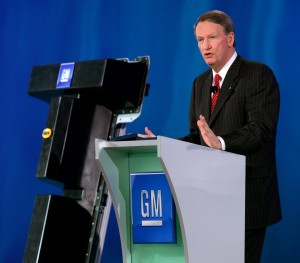
GM is number one in the U.S. again, only this time it's in an unwelcome monthly sales decline.
For car makers operating in the U.S., February brought more bad news as total sales dropped by more than 40%, and annual the sales rate dropped to a dismal 9.2 million units.
February also marked the second month in a row where more new vehicles were sold in China than the U.S. Chinese consumers bought approximately 740,000 vehicles, while U.S. consumers purchased fewer than 700,000.
By the numbers, General Motors sales dropped by -53%, while Ford Motor Co.’s sales fell -48% and Chrysler’s dropped -44%. However, Toyota Motor Sales also reported a -37.3% drop during February. Nissan’s sales fell -37%, and Honda sales dropped -35%. Sales of Volkswagen were -17%, Audi -24%, Mercedes-Benz -24%, BMW Group at -35%, and Lexus -38% — so all dropped by double digits last month, according to the sales figures released by the automakers Tuesday.
The only manufacturers to show an increase were Subaru, which registered a modest +1% sales increase and Kia which reported its sales were up by less than 1%. Other manufacturers such as Mazda ,where sales declined by -30% , and Mitsubishi ,where sales dropped by -50% are thought to have asked for a recount of Kia’s numbers.
“It’s a very tough market to operate in right now,” says Mike DiGiovanni, GM’s director of market analysis, who estimated that roughly 36 million Americans have lost their jobs or are concerned about losing their jobs.
“February was another downer for the whole market,” says Jim O’Donnell, president of BMW of North America, in a statement.
DiGiovanni estimates that American consumers purchased only 695,000 vehicles in February. “This was the lowest February (sales) on record, going back to 1967,” he says. “The top six (manufacturers) were down 37%.”
Carmakers say consumers remained spooked by unemployment, falling house prices and the ongoing plunge in stock prices.
“Americans are hunkering down, pulling in their horns. We estimate that fully two-thirds of the people don’t believe the economy will recover for five years,” says DiGiovanni.
“The pattern that emerged a few months ago seems to be continuing,” says Dick Colliver, executive vice president of sales for American Honda.
“Customers need a little bit of breathing room,” says Bob Carter, the head of the Toyota Division.
Nevertheless, the automakers persisted in seeing signs of hope in the dismal numbers, trying to talk up the market.
George Pipas, Ford Motor Co.’s top sales analyst says demand for used cars is increasing, which is a promising sign. Fleet sales also have dropped below more typical numbers for the past two months, he says.
Mark LaNeve, GM vice president of sales, service and marketing, says that while GM’s fleet sales have been scaled back for the past two months, retail sales of both passenger cars and crossover vehicles have improved. Sales of passenger cars and crossovers are critical to GM’s long-term recovery, of course.
Chrysler vice chairman Jim Press also notes that most of Chrysler’s drop in sales was accounted for by the 71% decline in fleet sales in last month. Chrysler’s retail sales have been holding their own despite tight credit, Press says.
“We’re putting all our resources in selling retail, which is where you make money in this business. Because we have a head start on restructuring, it’s not at the expense of our profit targets,” Press says.
Press also said the only reason Chrysler has asked for $5 billion in federal assistance at this point is because the financial crisis has taken a huge bite out of car sales over the past six months.
